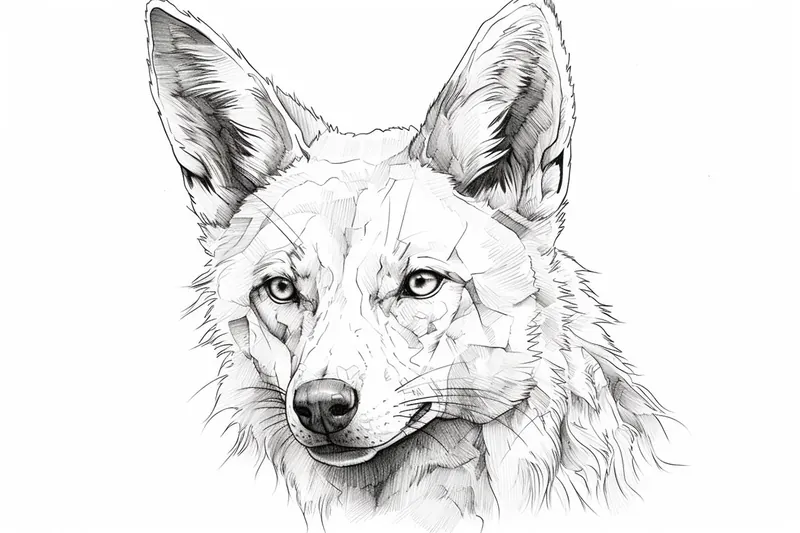How to Draw a Jackal
Learn how to draw a jackal with this step-by-step tutorial. Capture the grace and beauty of this magnificent creature in your own artwork.

Materials You'll Need
- Pencil
- Paper
- Eraser
 Welcome to this engaging step-by-step tutorial that will guide you through the process of how to draw a jackal. Whether you're an experienced artist seeking to refine your skills or a beginner eager to dive into the world of art, this guide is designed for you. The jackal, with its sleek, agile form and keen, intelligent gaze, is not only a captivating subject but also a fantastic opportunity to explore techniques in animal representation.
Welcome to this engaging step-by-step tutorial that will guide you through the process of how to draw a jackal. Whether you're an experienced artist seeking to refine your skills or a beginner eager to dive into the world of art, this guide is designed for you. The jackal, with its sleek, agile form and keen, intelligent gaze, is not only a captivating subject but also a fantastic opportunity to explore techniques in animal representation.
As you embark on this artistic journey, you'll discover the beauty of translating nature onto paper. Each stroke can bring the jackal to life, showcasing not just its physical features but also its unique character. This tutorial will break down each step, making it easy to follow along and develop your own artistic style, all while learning more about this fascinating creature.
So grab your favorite drawing materials and prepare to channel your inner artist. With patience and practice, you'll create a stunning representation of the jackal that you can be proud of. Let's get started!
Materials Required
To begin drawing your jackal, gather the following materials:
- Pencil: Start with a regular graphite pencil, preferably an HB or 2B, for sketching and shading.
- Eraser: Use a soft eraser to correct any mistakes or lighten certain areas of your drawing.
- Paper: Choose a smooth, thick paper that can withstand pencil shading without smudging.
- Reference Image: Find a clear photograph or a detailed drawing of a jackal to help you observe its features.
Now that you have all your materials ready, let's dive into the step-by-step process of drawing a jackal.
Step 1: Basic Shapes
Begin by sketching the basic shapes that make up the jackal's body. Start with an oval shape for the head and add a slightly elongated oval below it for the body. Sketch a straight horizontal line across the middle of the head to mark the position of the eyes.
Step 2: Facial Features
Now, let's focus on the jackal's facial features. Using the horizontal line as a guide, draw two almond-shaped eyes on either side of the head. Add a small triangular shape below each eye for the jackal's snout. Sketch a curved line between the snout and the head to form the mouth. Don't forget to add a small circle for the jackal's nose.
Step 3: Ears and Hair
Moving on to the ears, draw two pointed triangles on top of the jackal's head. These triangles should be slightly curved, resembling the shape of a leaf. Once the ears are in place, it's time to add some detail to the hair on the jackal's head and neck. Use short, quick strokes to create a sense of texture and volume.
Step 4: Body and Limbs
Refine the shape of the jackal's body by adding more curves and contours. Pay attention to the outline of the chest and the belly, ensuring that they flow naturally from one another. Extend lines from the body to create the jackal's limbs. Use a combination of straight and curved lines to form the legs and paws.
Step 5: Tail
Jackals have long, bushy tails, which add to their distinctive appearance. Draw a curving line behind the jackal's body to represent the tail. Add some texture to the tail by sketching short, overlapping strokes.
Step 6: Facial Details
Now, let's focus on the finer details of the jackal's face. Start by adding a curved line above each eye to indicate the eyebrows. Next, draw a couple of short, curved lines beneath the eyes to represent the jackal's cheekbones. Add a few more lines around the mouth and nose to define the snout.
Step 7: Eyes and Expression
The eyes are a crucial element in capturing the jackal's expression. Add some depth to the eyes by shading the area around the pupils and adding small highlights to indicate reflections. Experiment with different shades of graphite to achieve a realistic look.
Step 8: Shading and Texturing
Now it's time to bring your jackal to life by adding shading and texture. Start by shading the fur using short, light strokes in the direction of the hair growth. Use slightly darker strokes to add depth, especially around the jackal's face, ears, and limbs. Take your time with this step, as it can greatly enhance the overall appearance of your drawing.
Step 9: Final Touches
To complete your jackal drawing, take a step back and assess the overall composition. Make any necessary adjustments to balance the proportions and refine the details. Erase any stray lines or marks to clean up the drawing. Pay attention to the values and contrast, adding additional shading where needed.
Congratulations! You have successfully drawn a jackal. With practice, patience, and attention to detail, you can create stunning wildlife illustrations. Remember, each drawing is an opportunity to learn and improve your skills as an artist.
Tip: When drawing a jackal, focus on capturing the unique shape of its head and body, which are key to portraying its character. Begin with a light pencil sketch, outlining the basic shapes: an elongated snout, slender neck, and a curvy back. Use reference images to observe the jackal's proportions and distinctive features, such as the large, pointed ears and bushy tail. For added depth, employ cross-hatching techniques to suggest the texture of its fur, paying special attention to the direction of fur growth—this will enhance realism. Finally, don't hesitate to use an eraser to refine your lines and create highlights, helping your jackal appear lively and dynamic!
Conclusion
Drawing a jackal allows you to connect with nature and develop your artistic abilities. By following these step-by-step instructions, you can create a beautiful and lifelike representation of this majestic creature. Remember to observe the jackal's features and take your time with each step. With practice, your drawings will continue to improve. So grab your pencil, let your creativity flow, and enjoy the process of drawing a jackal.